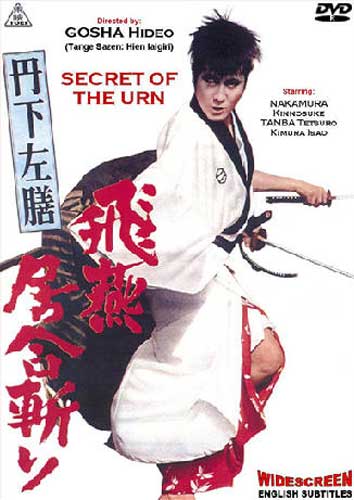Tange Sazen, the one-eyed one-armed swordsman (also known as "the lefty swordsman") is a folk figure from Japanese pop fiction of the 1920s & 30s, created by Hayashi Fubo, originally as a side-character in a 1927-28 serialized adventure novel Ooka Seidan: Suzukawa Genjuro then featured in his own serialized novel Tange Sazen in 1933 through 1934.
The character was first adapted to the "talkies" by the great director Daisuke Ito in 1933. Short silent films featuring Tange Sazen began appearing numerously by 1927, but these earliest primitive pieces were in general mere excuses for benshis or live film narrators to express their own repertoire of tales.
However, three 1928 films, constituting a trilogy, were likewise directed by the great Daisuke Ito, so it would be interesting to see a few of these silent films, to know more certainly their merits apart from the benshi. Daisuke's, at least, one would expect to really be something.
Tange Sazen is a "monster" by right of mutilation, & he's monstrous in battle. Generally he is a "family film" character, so despite his untrusting nature & degree of nihilism, he is by no means played as harsh or edgy, but as manic & smart-alecky, & he's especially manic as portrayed by Kinnosuke Nakamura in Tange Sazen: Hien iai-giri (Secret of the Urn, Toei, 1966), director Hideo Gosha's first color film.
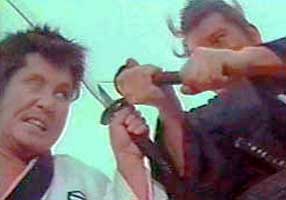 As a 1966 vehicle for Toei's high powered young star Kinnosuke Nakamura, there are additional fine performances from Tetsura Tamba as Lord Yagyu, Keiko Awaji as the crooked geisha Ofuji, Ko Kimura (aka Isao Kimura) as Lord Yagyu's son Yagyu Genzaburo, & Ryutaro Otomo as the Edo magistrate. It's packed with recognizable stars. As a 1966 vehicle for Toei's high powered young star Kinnosuke Nakamura, there are additional fine performances from Tetsura Tamba as Lord Yagyu, Keiko Awaji as the crooked geisha Ofuji, Ko Kimura (aka Isao Kimura) as Lord Yagyu's son Yagyu Genzaburo, & Ryutaro Otomo as the Edo magistrate. It's packed with recognizable stars.
Hideo Gosha was already a comparatively serious director, not the sort to be assigned such standard chambara fodder as the umpteenth Tange Sazen remake. He did try to make Sazen grittier than in most earlier versions, his wit openly hostile to samurai codes, scowling & bitter even when laughing. But Gosha was saddled with a figure as familiar in Japan as Zorro or Lone Ranger are in the west, & these are not the sorts of personas viewers will pay to see changed too much, so Tange Sazen remains something of a "comic nihilist" rather than the real deal.
Kinnosuke is not as dynamic playing Tange Sazen as when playing Musashi Miyamoto in the Tomu Uchida-directed series, as Mushashi is a more complex character to begin with. Plus it is often way too obvious with Kinnosuke's Tange Sazen that it is just the actor with one arm kept inside his sleeve.
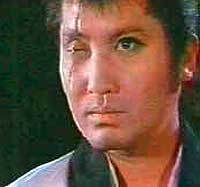 It's even so a delightful minor film & a good example for getting introduced to the popular character. It's even so a delightful minor film & a good example for getting introduced to the popular character.
We first meet the future Tange Sazen in a long pre-credits sequence, when he is the retainer Samanesuke, so dutiful that when he is instructed to kill his best friend, he sets out to do so, but is betrayed & loses his arm & eye.
When next we see him he'll be transformed into the monster who no longer believes in samurai virtue, mutilated but if anything an even better fighter than ever, due to having developed an unusual left-hand style that no swordsman was ever trained to defeat.
Guraku, a shogunate minister (Seizaburo Kawazu), is trying to ruin Yagyu clan for his own gain. He convinces the shogun to assign the Yagyus the "honor" of a shrine-rebuilding project which will bankrupt the clan, yet they dare not turn down the assignment.
Lord Yagyu consults the 120 year old Ippu, wise but he can't talk, who writes down that they should look at a brown pot on which is a coded map that will lead them to a hidden Yagyu treasure with which to fund the shogun's commission & preserve the clan.
The urn is wanted by several factions, including a girl thief & her brother (recurring characters in Tange Sazen adventures). Tange Sazen pretty much decides to cause trouble about it because he can, at first out of sheer comic orneriness. But soon he sides with the beleagured Yagyu clan against the evil minister.
He causes the minister to lose favor with the Shogun by rudely crashing a tea ceremony. Magistrate Ooka intervenes to pardon all of Tange Sazen's helpers, who were mostly just a pack of down-&-out thieves. But as for Sazen, he is exiled, which is better than being executed for messing up the Shogun's party, & a man like him doesn't mind wandering.
The minister's ninja bodyguard becomes a "stray dog" in a short epilog & attacks Sazen as he is leaving Edo, only to meet his just reward. All bad guys are punished, & Tange Sazen continues on his way, ready for his next Edokko townsman adventure no matter who should play him in future children's films about the one-eyed one-armed swordsman.
Secret of the Urn was intended as the first of a new Tange Sazen series, but better projects captured Kinnosuke's enthusiasm, & he never revisited the role. But director Hideo Gosha returned to the same story, updating the look of the film for the 1980s, including a jazzy score so good that it still sounds awfully good, rather than unsuited to a jidai geki setting or stuck in the 1980s.
This version of The Pot Worth a Million Ryo (Tange Sazen: Ken Fu! Hyakumanryu no tsubo, 1982) stars Tatsuya Nakadai in the central role. He obviously studied Denjiro Okochi's body movements & adopted the hopping gait in the fight sequences, but Nakadai adds other body posture traits that make the character visually his own.
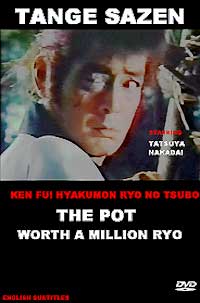 One problem with so many Sazen films is it's pretty difficult to hide the fact that the actor doesn't actually have only one arm. For Nakadai, too, when he's in his most intense action scenes, you'll catch glimpses of his supposedly missing arm's elbow poking at his kimono. But in the main, he has found postures that make him look authentically rawboned & one-armed. One problem with so many Sazen films is it's pretty difficult to hide the fact that the actor doesn't actually have only one arm. For Nakadai, too, when he's in his most intense action scenes, you'll catch glimpses of his supposedly missing arm's elbow poking at his kimono. But in the main, he has found postures that make him look authentically rawboned & one-armed.
He tends to keep the "armless" shoulder higher than the other giving himself a sharp angular look on that side, & rests his drawn swordblade on the armless shoulder between slashes & cuts (Denjiro tended to rest his sword on his right shoulder so as not to draw too much attention to the fact that his left arm was sometimes detectible).
A Nakadai fan will be reminded how in films like Harakiri (1962) he developed a crossed-arm stance uniquely his own, as in Sword of Doom (Daibosatsu toge, 1966) he developed a seemingly "unbalanced" stance leaning strongly to one side, reflecting his unbalanced mind, or in Goyokin (1969) when he began his duels with his sword pointing partway behind himself.
Probably no other post-war or modern jidai geki actor has had quite so full an understanding of the visual impact of posture & created so many unique images. But the best silent & pre-war film stars like Denjiro Okichi did have a similar knack.
If I were to fault anything in the character's visual impact, it would be the make-up for the ruined eye, which is so black & blue & lumpy that it looks rather goofy, though intended to heighten Sazen's monstrousness.
The plot follows much the same course as in Gosha's earlier version with Kinnosuke, but there are sufficient alterations to feel like a brand new take on the familiar tale.
Tange Samonosuke is assigned the awful task of killing a fellow vassal of the Yagyu, a man who was his childhood friend. But it cannot be known that the Yagyu would assassinate their own retainer, so Samonosuke will have to accept the planted rumor that the duel was due to a falling out between the friends, both of whom fell in love with Hagino (Masako Natsume).
When confronted with the Yagyu knowledge that he has been spying, Samonosuke's former friend falls to his knees & rips open his kimono, asking his would-be killer to instead be his decapitating "second" as he commits seppuku. But it is a trick, & Samonosuke's sword arm is swiftly cut off with the seppuku blade, as other samurai leap forth & attack the innocent man, destroying his right eye.
The Yagyu had betrayed him from the start & made him a fall-guy. Rage builds in him for the Yagyu. He vanishes for a long time & is presumed to have died, but he heals & returns to Edo under a new identity, a town-knight named Tange Sazen, who sleepily malingers & drinks in the ghetto quarters, & womanizes if he gets the chance.
He acts gruff & dangerous though in fact he has a chivalrous nature that only those closest to him ever comprehend, & he has grown fond of though not necessarily friendly toward society's misfits & outcasts & criminals.
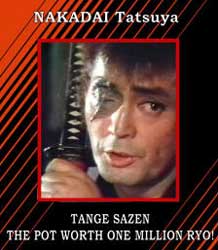 Meanwhile Ippusai, the 120-year-old Yagyu retainer, reveals the secret of the map embossed inside the heirloom Kokezaru urn, a coded map to a hidden treasure. The Yagyu, instructed to repair an ancient temple, would have been bankrupted by the Shogun's command, but a previous generation of Yagyu hid this treasure against just such a future occasion. Meanwhile Ippusai, the 120-year-old Yagyu retainer, reveals the secret of the map embossed inside the heirloom Kokezaru urn, a coded map to a hidden treasure. The Yagyu, instructed to repair an ancient temple, would have been bankrupted by the Shogun's command, but a previous generation of Yagyu hid this treasure against just such a future occasion.
As the impossibly venerable retainer reveals this secret for the first time in the four generations he has served, there happens to be a thief in the rafters who learns of the "million ryo pot" at the same time the Yagyu daimyo learns of it.
There is also a shadowy enemy of the Yagyu, white-haired Guraku (Ko Nishimura), carrying a grudge since his youth. Together with his spectacular agent Taiken (Isao Natsuyaki) who calls himself the God of Death, & other agents faithful to Guraku, they intend to waylay the transport of the urn & deprive the Yagyu of the million ryu the urn will lead them to.
Thus a gang of acrobatic ninja including kunoichi (female ninja) attack the transport. The primary guard, severely wounded, flees to the riverside with the pot & happens upon an orphan child, Chibayasu (Minoru Sakurai), telling the boy to protect the pot for the Yagyu. This command Chibayasu, enamored of samurai, takes very seriously.
Chibayasu is in turn cornered by a man & a woman who have been watching this action from a safe vantage-point. One is that rafters-thief Yokichi (Kazano Ikkaku) & the other Ofuji (Kayo Matsuo) the gangsterish woman he serves. They demand the urn from the boy. But it soon appears that none of them will hold it long, when Yagyu men surround them.
When Tange Sazen grabs the jar, he doesn't know its value beyond the fact that the Yagyu are awfully clear about wanting it back. He still bares a high degree of anger, if not an actual grudge, against the Yagyu. So he just keeps it to be mean.
The relationship between Sazen, Ofuji, Chibayasu, & Yokichi, & to some degree also to Yagyu Genzaburo (Isutomu Watabe) & the innocent Hagino, is of signal importance. Well developed interactions show people changing & growing.
Ofuji for large example makes a living partly as a naniwabushi performer, meaning she sings & recites "ninjo" or chivalrous tales about sad & heroic people, accompanying herself with the shamisen. This is a tough-spirited form of storytelling & she has quite a following among the impoverished underclasses of her neighborhood. But low-placed musicians don't get rich, so she involves herself in crime a well, including thievery & prostitution.
She is at first a gun-toting bad-girl who'd be willing to kill Sazen for the jug, but soon realizes she'll need him if only as a bodyguard against the highly murderous agents of Guraku. In the course of the tale she falls deeply in love with Sazen, unconcerned with his monstrous looks. But being herself a hard drinking fighter with a bad temper, she has trouble showing her feelings in complete honesty, so that disagreements & misunderstandings are inevitable between them.
Some of Sazen's other relationships are almost as fully developed, but there's also plenty of action at regular intervals.
Genzaburo is the primary vassal of the Yagyu after the jug & he's a decent enough man though he'll kill if he has to. But that Guraku's a real sonuvabitch who'll kill even if he doesn't have to. One action sequence begins with Sazen taking a duplicate of the urn to Guraku, demanding & receiving 100 ryu for it.
Even before Guraku realizes he has purchased a fake, he sends his monk warrior Ikkaku Kazama (Kyoichi Sato) to kill Sazen. Ikkaku has a two-sword sword-throwing fighting technique which he is convinced no one-armed man can fend off, har har. He does die prettily at least, after the mutual exchange of insults. "Wild dog!" he says to Sazen, & Sazen fires back, "Kept dog!"
The story comes to a fight-filled chivalrous close with Sazen coming to terms with Genzaburo & returning the urn; Guraku to be punished by the shogun; & the largely good samurai Echizen (Ichiro Nakatani) in service of the shogun banishing Sazen from Edo in exchange for full liberty of the many thieving crooked friends he has made among the city's criminal class.
This means Ofuji will be able to settle down to a more honest life & be a mother to the orphan boy. But it is not all happiness, as she would've liked to have lived with Sazen who cannot stay.
Along the road away from Edo, Sazen encounters Taiken the self-titled God of Death, now himself a masterless dog, believing his new wild life will begin lucky if he can begin it by killing Sazen.
This jidai geki tradition of a film's coda presenting one last carefully orchestrated one-on-one duel is something I really never tire of. It's a perfect way to end a tale "a second time" after the primary ending. It only has to be "pretty well done" for me to love it, but in this case, it was awesome. Sazen remains a man of shocking surprises right to the end.
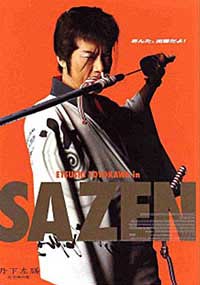 This wonderful film is rather episodic in structure because it was made for television & needed cliffhanger breaks for advertisements. But Gosha loved the material & did well by it, making a very cinematic telefilm. This wonderful film is rather episodic in structure because it was made for television & needed cliffhanger breaks for advertisements. But Gosha loved the material & did well by it, making a very cinematic telefilm.
Tange Sazen's story of the urn with the map to the Yagyu treasure continued to be remade. Not only did Hideo Gosha film it first with Kinnosuke Nakamura (1966) & again with Tatsuya Nakadai (1982), but young director Toyoji Tsuda directed it with Etsushi Toyokawa in the central role & Emi Wakui as Ofuji, played with an "edge."
The DVD box for (Tange Sazen: Hyakumanryo no tsubo, 2004) is shown in the final illustration with its shortened title Sazen. A real homage to the history of jidai-geki, with beautiful stars & lovely themesong.
Toyoji Tsuda did not merely direct an updated version, but shot his version almost frame for frame in homage to Sadao Yamanaka's very first version from 1935, so the influence of that early film has never dwindled, & discussion of that film will start off Part II of this essay, if you follow the link immediatey below.
copyright © by Paghat the Ratgirl
|

